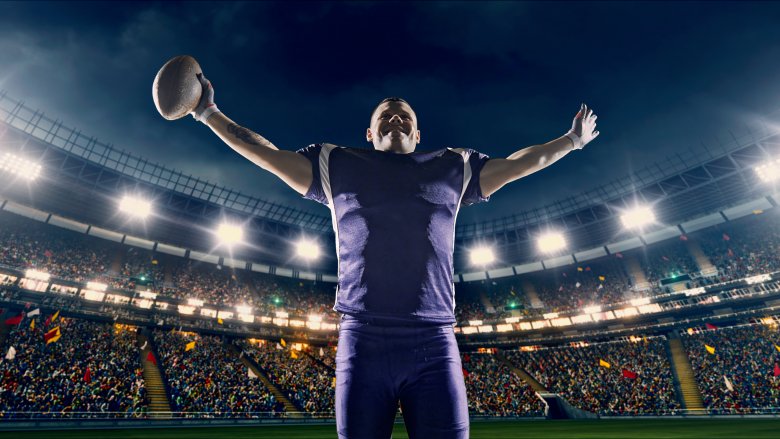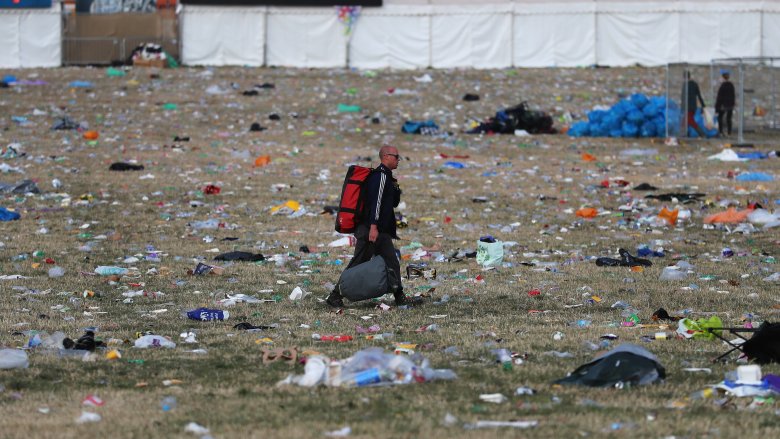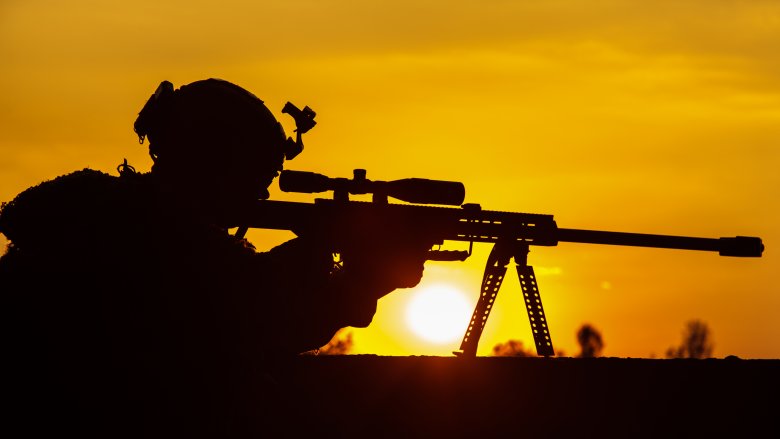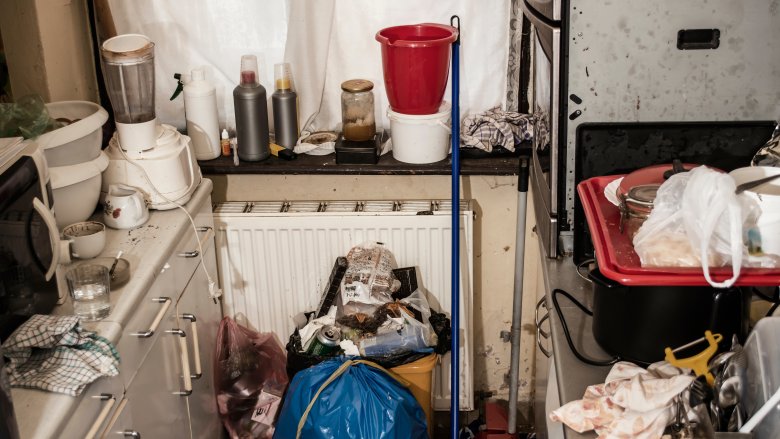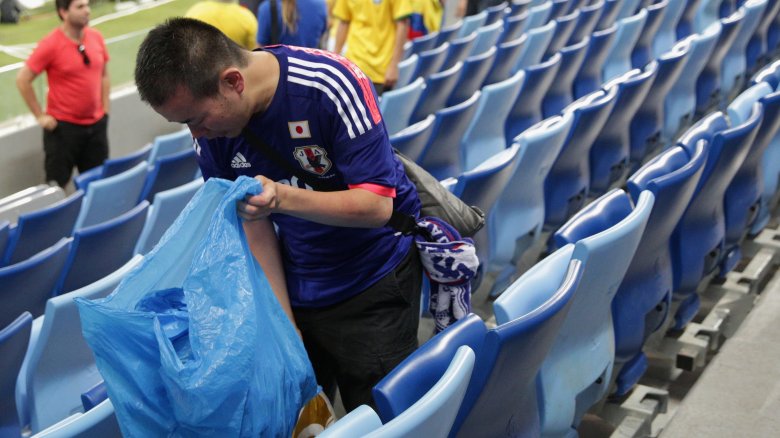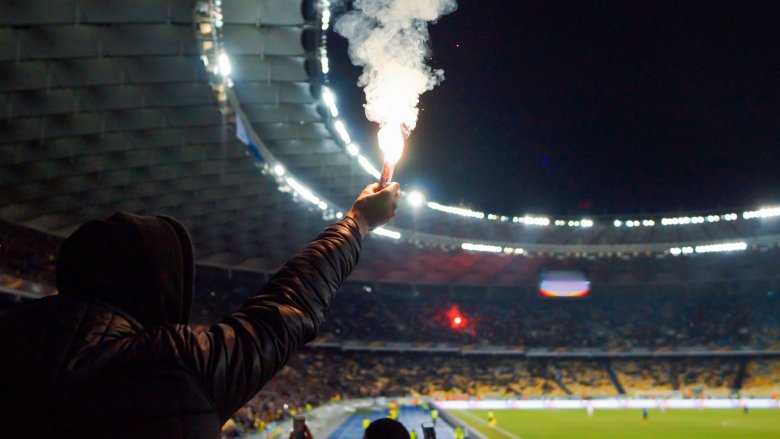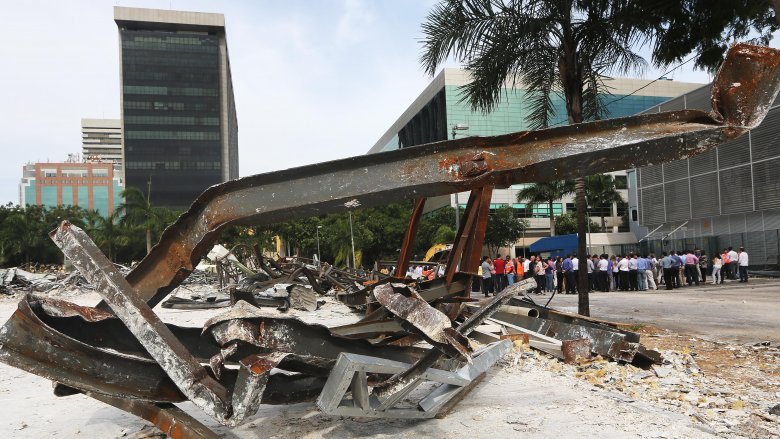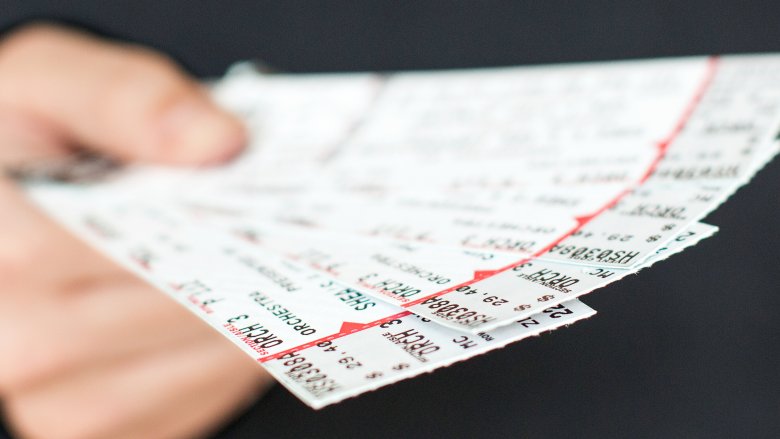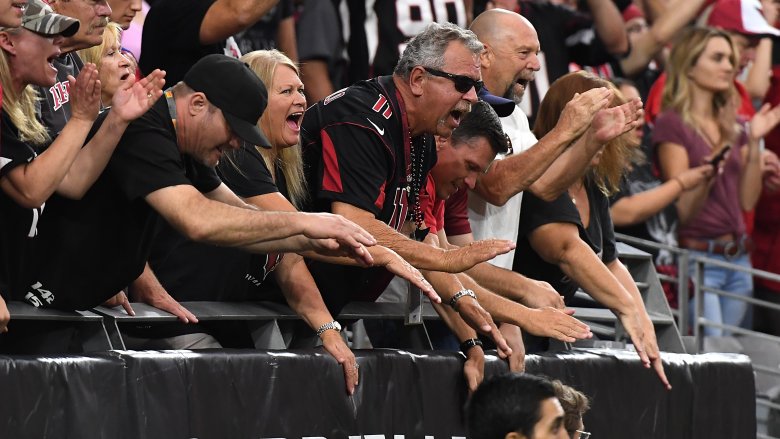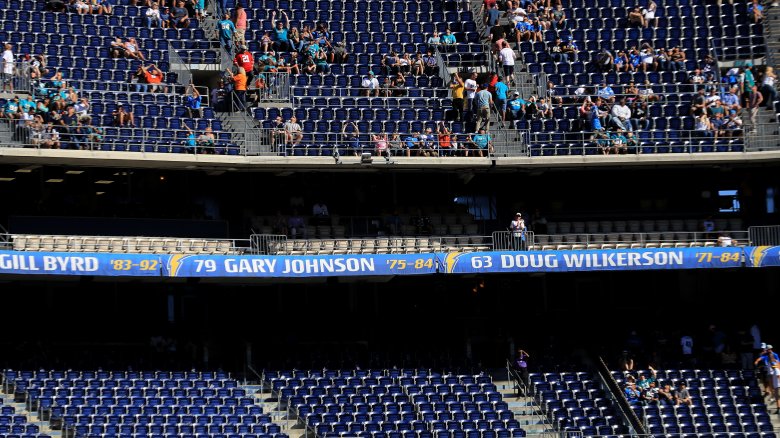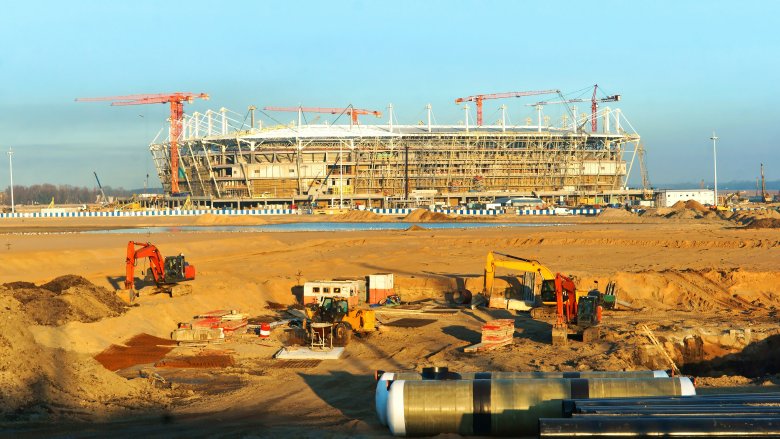What Sports Arenas Don't Want You To Know
Ah, sports. For whatever reason, humans have spent countless centuries cheering from the sidelines as our chosen ones race across fields, battle to the death with swords, or swat a ball around until it eventually hits some sort of target. While armchair quarterbacks around the world would love to be up on the field, the next best thing is definitely sitting in the stands. Breathing in the smells of the sports arena, seeing your favorite team play right before your eyes, with millions of fellow fans around you, and maybe even a hot dog in your hand — that's heaven for sports fans.
While traditions like the Super Bowl are important cultural touchstones, it's worth examining some of the strange rules, politics, sanitation snafus, and fire safety issues going on in your local stadium or arena. Even if everything looks bright and shiny, sports arenas sometimes hide dark secrets. Don't let any of this deter you from enjoying a good sports game, of course — not that anything ever could — but keep your eyes open for these weird little details.
They're sometimes built over cancerous old landfills
Imagine you're a baseball player. Okay, now imagine that as you're running onto the field past second base, your foot suddenly slams into a random piece of metal, which turns out to be a half-buried old kettle. Weird, right? Now picture that the whole game has to halt so they can dig this stupid kettle out of there. Silly as this sounds, Mental Floss points out that this bizarre event did happen to World War II-era White Sox player Luke Appling. Nothing like a little thrift store merchandise with your balls and bats, eh?
Several huge sports stadiums were built on top of landfills, including Chicago's Comiskey Park and the old Giants Stadium in New Jersey. So yeah, there's a lot more trash under those fields than a little kettle. But is it a problem? Considering how awful landfills are, maybe this is a good way to re-purpose the land.
Well, not really. In the 1980s, the Washington Post reported that four New York Giants players had been diagnosed with cancer in the same timespan, which isn't normal among a group of young athletes. Evidently, all the nasty junk under the field was a bigger problem than people realized. While finding solutions for old landfills is an environmental necessity, building people-packed stadiums on top of them doesn't seem to be the best idea.
There's a guy with a sniper rifle hiding up in the rafters
Remember that scene in The Dark Knight Rises where Bane collapses a whole football stadium, kills a bunch of people, then brags about having a bomb? Well, these days, most stadiums are guarded by a little extra security: a sniper's nest, high above the stadium, where some guy with a gun looks down over the field in case things gets wonky.
Business Insider posted photos of the sniper hanging out above Lucas Oil Stadium during the 2012 Super Bowl, and Deadspin confirmed that having snipers at massive sporting events has become standard procedure, particularly since any game might have any number of politicians, celebrities, and other folks in attendance. Still, even though snipers have become the norm, it's a little weird to think that as you're chomping down on that hot dog, some guy with a rifle is scanning the crowd. Hopefully you're both rooting for the same team. Take me out to at the ball game, huh?
You don't want to know about those kitchens
People pour a lot of junk down their throats on a daily basis, but nobody ever wants to go to any restaurant with a C sanitation grade posted on the wall. You'd hope that all the cheesy, greasy, sugary food that gets served at the ball game is properly sanitized, if not healthy, but ESPN's investigation into the matter didn't turn up such great results.
Naturally, there are going to be problems when you have underpaid, understaffed kitchen workers slaving away in tiny quarters, serving millions of people. But when these problems involve hands not being washed, much less dirty ice machines, cockroaches creeping on soda machines, and meat being served at improper temperatures ... well, it kinda ruins a person's appetite. While there hasn't been any documented outbreak of foodborne illness coming from a big game — so far — ESPN found that when they assessed all 107 North American stadiums and arenas, 28 percent of them had been cited at least once for either a "critical" or "major" health violation.
Of course, as Sports Illustrated points out, part of the problem is stadiums don't just serve hot dogs and peanuts anymore: the fancier the food, the more complicated the sanitation procedures. Experts mostly agree that the solution is more training for food handlers, publicizing all kitchen inspection reports, and more safety awareness in general. If not, more people are going to start bringing lunchboxes.
Today's big sporting events have huge environmental consequences
Sure, when you're busy cheering on your favorite football star, you probably don't want to expend mental energy worrying about whether your hometown will be swept away by the ocean in a few decades. But whether you're worried about the environment or not, the environment is worried about you, and Forbes points out that giant sporting events — particularly the Olympics, which generates monolithic new stadiums every few years — can be an immense burden on the planet's resources. The biggest problem, as usual, is carbon emissions. A single sporting event creates mountains of trash and food waste plus crazy energy consumption, and requires a huge amount of water to both nourish the fields and make the toilets flush.
And sure, environmental damage isn't the most exciting topic in the world, but if we want to still be playing football in a few hundred years instead of just having hyper-evolved, telepathic cockroaches dig our fossils out of ancient football stadiums, we have to build and manage stadiums more responsibly, and you need to start picking up your trash. Big sporting events don't have to trash the planet, as long as we all do a little better.
Fire code? What fire code?
Okay, everyone knows a sports arena is one of the last places you'd want to be if Godzilla started spraying his atomic breath willy-nilly. Nonetheless, you'd think the powers-that-be would be carefully monitoring the fire safety system, doing regular updates, and making sure everything is in tip-top shape. However, if you ever wanted a little extra source of anxiety as you sit in the stands, Dalmatian Fire offers this gentle reminder: Aside from how the unique designs of stadiums make fire safety a bit more difficult than usual, some old stadiums are historic structures that have never been properly retrofitted with state-of-the-art fire protection systems. Yes, Dalmatian Fire is saying this to sell their fire safety products, but that doesn't make it less scary.
Now, in all fairness, plenty of stadiums have shelled out the cash to get their fire systems updated, considering the potential PR catastrophe if they didn't. One stadium that isn't on the ball, though, is over at Georgia State University. In 2017, local news stations reported that a recent inspection had found the majority of the stadium's sprinkler systems and their fire pump either didn't meet safety standards or were nonexistent. Oops?
Stadiums aren't always great for the neighborhoods
Stadiums built on landfills might be problematic, but at least they didn't displace entire neighborhoods full of people, homes, and history. When giant arenas are built in populated areas, it often means tearing up a whole section of town, and it's never the place where all the rich folks sip on expensive cocktails: As always, the economically disadvantaged neighborhoods suffer the consequences, with everything from small family-run businesses to low income housing being demolished in the name of gentrification. As The Nation rather bluntly put it, "stadiums ruin neighborhoods."
This definitely happens in the United States, but it's a problem in other parts of the world, as well. A lot has been written about how the 2016 Summer Olympics devastated the Rio economy, but back in the early stages, CNN highlighted the fact that people's childhood homes were being demolished to make room for the worldwide event. The Olympics displaced 800 families, and many were moved to federal and municipal housing projects. This was one of many dark shadows left in the wake of the 2016 Olympics that Rio is still grappling with today.
You think those tickets are too expensive? Yeah, you're right
Doesn't it seem like getting tickets to a big game costs way, way more than it used to? Don't listen to anybody who points to inflation. As Forbes notes, the average ticket price to see a Major League Baseball team has risen 340 percent since 1957 – after adjusting for inflation. What's the deal?
You guessed it: greed. Ticket prices are constantly being repriced so the folks with a lot of money can make even more money, with prices going up when a team goes on a winning streak, has a great previous game, or even if the weather is particularly bright and shiny. Rising player wages have also been shifted onto the consumer. The overall result of this dollar-grabbing is when a championship game arrives and the streets are lit up with excitement, it can cost hundreds of dollars to bring your family to see your favorite team, locking out countless fans who just don't have the funds to justify the expense.
Don't forget about your ears
These days, everyone has gotten so used to stories about loud music causing tinnitus (you know, ringing in the ears) that nobody is surprised when rock stars like Eric Clapton start wearing earplugs. However, one alarming truth is that going to a lot of loud, rowdy sports games can just as easily ruin your hearing. As NPR points out, the average crowd noise at any NFL game hovers between 80 and 90 decibels. What's the problem? Being surrounded by over 85 decibels of volume for more than eight hours can cause permanent, irreversible hearing damage. At 88 decibels, that recommended time gets cut in half to four hours. At 91 decibels, you should only be around it for two hours. You get the gist.
Sports audiences sometimes soar well over 100 decibels. While one exposure is enough to cause damage, the bigger concern is for repeat attendees who frequently go to loud games. The solution? Easy. Buy some ear plugs for less than a couple bucks, stuff 'em in, and don't worry about it. Sure, they look goofy, but they're a lot better than asking people to repeat themselves over and over.
The NFL's empty stadium problem (kinda)
Even if you don't follow sports, you've probably been hearing about the many controversies surrounding the NFL in the last few years. One thing the NFL hasn't been talking about, though, is that for all those expensive tickets, big games have been seeing more empty seats than usual. As The Big Lead noted in 2017, it doesn't look good for the league when TVs across the nation are showing major stadiums with fewer attendees than a junior high lacrosse game. Part of the problem seems to have been caused by relocating teams to the wrong areas. Bad stadium design might also be a problem: For example, if you want to see the 49ers play at Levi's Stadium, you'll be sitting out in the hot sun getting crispier than a burnt French fry.
Whatever the cause, the symptoms are getting increasingly evident. In 2017, FiveThirtyEight reported that the recently relocated Rams struggled with the worst attendance decline in decades. It's not a good look, but the NFL hasn't gotten the point of selling stadium chairs at yard sales. However, don't weep too many tears for the purveyors of pigskins. As the New York Times points out, NFL football is still easily the most popular sport in the United States.
New stadiums are built on tax dollars, and it's a bad public investment
When a big new sports arena gets constructed in your city, who pays for it? Probably you. In many cases, your tax dollars are flying from your wallet like a home run, soaring into every bulldozer, grass seed, and kitchen supply. Pacific Standard writes that in the United States, over 100 new stadiums and arenas have been built over the past few decades, and almost all of them have received funding from local taxpayers.
The problem is that while the whole "creating jobs, funneling in revenue" spiel sounds great in theory, stadiums are actually a terrible public investment. Any jobs created are either temporary or have comically low wages. As for all that new revenue? Most stadiums are closed more than they're open, and the revenue they create for a town could've easily been generated by genuine local businesses like coffee shops and movie theaters. That doesn't mean sports complexes are a bad thing: It's just that the benefits a town receives from them usually don't compare to the cost of public funding. Economists have long warned that giant new stadiums are a poor public investment, but the Los Angeles Times points out that in recent years, regular people are fighting back, such as in 2017, when voters in San Diego voted against the Chargers' efforts to build a new stadium using public funds.
